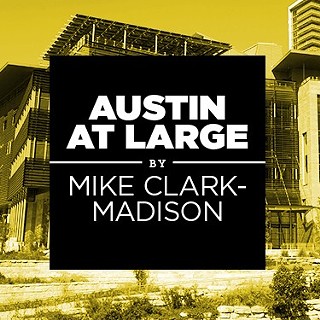Austin at Large: Too Late to Turn Back Now?
The long, slow slog to a new I-35 could still change direction
By Mike Clark-Madison, Fri., Nov. 20, 2020
Our most unloved neighbor, I-35, is back in the headlines; now is your chance to express your views on the path of least resistance taken by the state's $8 billion plan to rebuild the highway within the Austin city limits. The Texas Department of Transportation is currently conducting the "public scoping" phase of the federally required studies for what it calls the Capital Express Central project. That's the most difficult and expensive ($5 billion) segment between Hwy. 290 E. and Hwy. 290 W./Ben White Blvd., which will remove the upper decks between MLK and Airport, depress the mainlanes through Downtown, and add two "managed" (but not tolled!) lanes to shave a few minutes off travel time for carpoolers and transit users. Because of COVID-19, the scoping is all online at capexcentral.mobility35openhouse.com, and you have until Dec. 12 to submit comments, to which TxDOT is obligated to respond eventually, perhaps to your satisfaction.
I may be projecting here; some of y'all are likely eager to see years of massive and costly roadwork to make I-35, for a few years, a somewhat more efficient car sewer running right through the middle of town. It is true that TxDOT has made some modest adjustments to its past approaches to design and to collaboration with cities and the public. The alternatives on offer do not appear to require a bunch of new right-of-way, although we're still several years away from knowing that for sure. Nor do they yet foreclose opportunities to do something useful with the space above the Downtown mainlanes – the "cut and cap" or "cap and stitch" scenarios that are championed by most local stakeholders.
Purpose and Need
As someone who designed public involvement efforts for projects like this, I think TxDOT has done an OK job with its virtual open house. Ironically, among my past projects was the now-defunct Lone Star Rail plan to connect the Austin and San Antonio metro areas by train, which in a better world would be one of the alternatives being studied here, but the state foreclosed that option back in 2014. Ever since then, the only options on the table have been managed lanes or "no build"; the current alternatives simply vary the placement of those lanes (tunneled under the mainlanes or alongside them). That doesn't give TxDOT's public involvement team and consultants a lot to work with.
The NEPA process – that's the National Environmental Policy Act of 1969 – has three main phases. In scoping, the lead agency (TxDOT here) develops a plan to coordinate with stakeholders (e.g., the city of Austin) and defines the "purpose and need" for the project. That sets up the criteria by which alternatives will be evaluated in the second phase, which involves engineering and environmental study, and thus takes longer. The last phase identifies a "locally preferred alternative" to be considered by the relevant folks in D.C. (in this case, the Federal Highway Administration), who then issue a "record of decision." Once you get a ROD, you're free to build as long as you have the cash, which TxDOT has secured over the past two years.
Now, TxDOT has been studying what-to-do-about-I-35 in some form or fashion for about 35 years, and its version of the project's purpose and need reflects truisms known at this point by most all Central Texans. The metro area population is at least six times larger now than when the highway was first built in the early Sixties (the upper decks came in 1975). The highway falls short of almost all current design and safety standards and accounts for a disproportionate number of traffic injuries and fatalities, including on its frontage roads. If left unchecked, congestion will theoretically lead to routine hours-long traffic delays by 2045 – just for reference, at the posted speed limit it should take less than 10 minutes to travel the CapEx Central segment.
The Price We've Paid
Though the numbers have grown larger over the years, that basic narrative has been true the whole time. But what's not addressed by the purpose and need, in any direct way, is the impacts that I-35 has had on Austin – as a jagged rip in the urban fabric like so many highways in America; as a symbol and an instrument of a century's worth of environmental racism; and as a health hazard not just for those traveling on it, but for all who live nearby and, we understand now, the entire planet and its climate. Those are mostly not TxDOT's job to address, even if the actual engineers and planners working on the CapEx Central appreciate them.
So what can be done? There are potential paths to someplace better. Traffic projections may be fluid given Austin's approval of Project Connect and any permanent changes in travel behavior spawned by the pandemic. Direct harms to communities and their historic and environmental resources may be captured in the NEPA process and could lead to legal action. There's a new rearguard action to force TxDOT to consider an urban boulevard concept, which has succeeded in cities that have removed their central highways. But all of these, as well as whatever mitigation can come with "cap and stitch," can only really happen if you make your voice heard now, during scoping. Let's make it a goal to swamp TxDOT with our feedback over the next few weeks.
Got something to say? The Chronicle welcomes opinion pieces on any topic from the community. Submit yours now at austinchronicle.com/opinion.







